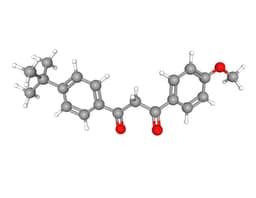Avobenzone

Summary: A chemical UVA filter that uniquely protects against long-range rays up to 400 nm.
Published on: 23/04/2025
Avobenzone (INCI: Butyl Methoxydibenzoylmethane) is a synthetic oil-soluble sunscreen agent used in topical formulations to absorb UVA radiation (320–400 nm) [1]. It is currently one of the most widely used filters providing broad-spectrum UVA protection, essential for preventing long-term photodamage, photoaging, and skin cancer.
Mechanism of Action
Avobenzone is a dibenzoylmethane derivative that absorbs UVA radiation by converting it into less harmful infrared radiation (heat). Its primary strength lies in its ability to absorb long UVA1 wavelengths up to 400 nm, which many other filters cannot efficiently block [2,3].
Photostability and Formulation Concerns
Avobenzone is photounstable, meaning it degrades when exposed to sunlight. Within one hour of UV exposure, it can lose up to 36% of its protective ability unless stabilized [4]. This instability can compromise sunscreen performance and lead to the generation of reactive oxygen species (ROS) [5], which are highly reactive molecules that can damage cellular components such as DNA, proteins, and lipids, contributing to oxidative stress and accelerating skin aging and inflammation.
To prevent degradation, avobenzone is often combined with photostabilizers such as:
-
Diethylhexyl syringylidene malonate (Oxynex ST) [6]
It is incompatible with mineral filters like zinc oxide and titanium dioxide in their untreated forms, as they can accelerate avobenzone breakdown unless encapsulated or coated [7].
Safety and Regulatory Status
Avobenzone is generally well-tolerated and has low skin penetration. In vivo and in vitro studies show that it rarely causes irritation or sensitization in humans [8].
Regulatory Limits
-
United States (FDA): Approved for use in sunscreens up to 3% concentration [9]
-
European Union: Approved up to 5% [10]
Conclusion
Avobenzone remains one of the most effective UVA filters available in cosmetic formulations. While it is photounstable on its own, formulations that include stabilizing agents can deliver broad-spectrum protection. Awareness of ingredient compatibility and regulatory limits is essential for effective and safe sunscreen formulation.
References
-
Beasley, D. G., & Meyer, T. A. (2010). Characterization of the UVA protection provided by avobenzone, zinc oxide, and titanium dioxide in broad-spectrum sunscreen products. American Journal of Clinical Dermatology, 11(6), 413–421.
https://pubmed.ncbi.nlm.nih.gov/20806994/ -
Cowden, A. M., Whittock, A. L., Holt, E. L., Stavros, V. G., & Wills, M. (2023). Synthesis and characterisation of novel composite sunscreens containing both avobenzone and octocrylene motifs. RSC Advances, 13(25), 17017–17027.
https://www.ncbi.nlm.nih.gov/pmc/articles/PMC10245224/ -
Sander, M., Burbidge, T., Sander, M., & Beecker, J. (2020). The efficacy and safety of sunscreen use for the prevention of skin cancer. CMAJ: Canadian Medical Association Journal, 192(50), E1802–E1808.
https://www.ncbi.nlm.nih.gov/pmc/articles/PMC7759112/ -
Abdassah, M., Aryani, R., Surachman, E., & Muchtaridi, M. (2015). In-vitro Assessment of Effectiveness and Photostability Avobenzone in Cream Formulations by Combination Ethyl Ascorbic Acid and Alpha Tocopherol Acetate. Journal of Applied Pharmaceutical Science, 5(06), 070–074.
https://japsonline.com/admin/php/uploads/1532_pdf.pdf -
Silva, J. P. S., Afonso, S., Horita, K., Almeida, I. F., Amaral, M. H., Lobão, P. A., Costa, P. C., & Bahia, M. F. (2024). Evaluation of the photoprotective and antioxidant potential of an avobenzone derivative. Frontiers in Physiology, 15, Article 1347414.
https://www.frontiersin.org/articles/10.3389/fphys.2024.1347414/full -
Chaudhuri, R. K., Lascu, Z., Puccetti, G., Deshpande, A. A., & Paknikar, S. K. (2006). Design of a photostabilizer having built-in antioxidant functionality and its utility in obtaining broad-spectrum sunscreen formulations. Photochemistry and Photobiology, 82(3), 823–828.
https://doi.org/10.1562/2005-07-15-RA-612 -
Kockler, J., Oelgemöller, M., Robertson, S., & Glass, B. D. (2014). Influence of titanium dioxide particle size on the photostability of the chemical UV-filters butyl methoxy dibenzoylmethane and octocrylene in a microemulsion. Cosmetics, 1(2), 128–139.
https://www.mdpi.com/2079-9284/1/2/128 -
U.S. Food and Drug Administration (FDA). (2021). Sunscreen Drug Products for Over-the-Counter Human Use. Safety Data Submission on Avobenzone.
https://downloads.regulations.gov/FDA-1978-N-0018-15718/attachment_1.pdf -
U.S. Food & Drug Administration (FDA). (2021). Final Administrative Order (OTC000006): Over-the-Counter Sunscreen Drug Products for Human Use.
https://dps-admin.fda.gov/omuf/omuf/sites/omuf/files/primary-documents/2022-09/Final%20Administrative%20Order%20OTC000006_M020-Sunscreen%20Drug%20Products%20for%20OTC%20Human%20Use.pdf -
European Commission. (2024). Annex VI – UV Filters Allowed in Cosmetic Products. Entry 15: Butyl Methoxydibenzoylmethane (Avobenzone) – Maximum concentration allowed: 5%. In Cosmetic Products Regulation (EC) No 1223/2009.
https://ec.europa.eu/growth/tools-databases/cosing/reference/annexes/list/VI